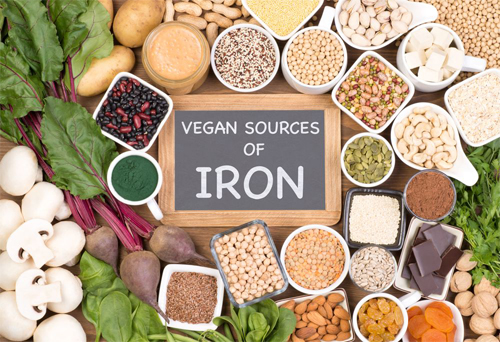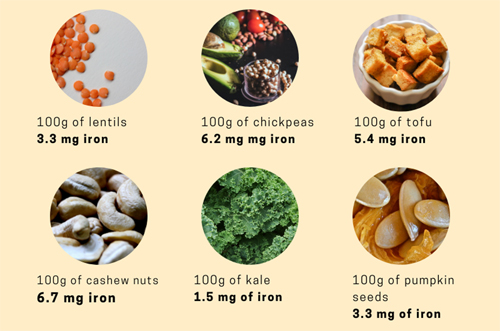Your iron levels could be a key to slow aging and long life
Iron is essential to life, but data show that too much is associated with aging and a shortened life and health spans — the total years lived in good health. High iron levels also increase the availability of free iron, which promotes heart cell death, leading to impaired heart function and mitochondrial dysfunction. Excess iron affects blood pressure and glycemic control. Levels build with increased intake and the body’s poor ability to excrete extra iron.

Iron is an essential nutrient, integral to hundreds of biological functions including oxygen transport, DNA synthesis and energy metabolism. Almost every cell in your body contains iron. Plants, bacteria, animals and even cancer cells cannot survive without it.
Plants use iron to make chlorophyll, while animals and humans need it to make hemoglobin, a protein in your red blood cells used to transport oxygen. Approximately 6% of the iron in your body is bound as a component to proteins and 25% is stored as ferritin.
Having too much or too little can have serious consequences. Yet, what many people and physicians do not realize is that an excessive amount of iron is more common than having a deficiency.
Doctors may check for iron deficiency as it relates to anemia, but iron overload is a far more common problem. Adult men and non-menstruating women are at risk of having dangerously high levels of iron. When left untreated, excess iron can damage your organs and contribute to the development of heart disease, diabetes, neurodegenerative diseases and cancer.
High Levels of Iron Linked to Shorter Life Span
Researchers have linked iron overload to several medical conditions, and now find that people age at different rates when they have excess amounts in the body. European scientists gathered data from an international database to test this theory.
The set of data was equivalent to about 1.75 million lifespans. They looked at the total number of years lived (life span), the total number of years marked by good health (health span) and living to an old age (longevity). The researchers identified 10 loci in the genetic sample that appear to influence aging.
The majority of the loci were associated with cardiovascular disease. Based on statistical analysis, the data suggested “that genes involved in metabolizing iron in the blood are partly responsible for a healthy long life.”
The new information is exciting as it suggests a modifiable pathway to explain biological aging and chronic disease rate differences among people. The researchers noted that high iron levels can reduce “the body’s ability to fight infection in older age,” which may be yet another reason that age is a factor in infectious disease severity.
As Paul Timmers from the University of Edinburgh says, the data also offer a reasonable explanation for the association between red meat and heart disease. While cholesterol has been blamed in the past, in a growing number of studies, no association has been found between cholesterol and heart disease. Timmers commented:
“We are very excited by these findings as they strongly suggest that high levels of iron in the blood reduces our healthy years of life, and keeping these levels in check could prevent age-related damage. We speculate that our findings on iron metabolism might also start to explain why very high levels of iron-rich red meat in the diet has been linked to age-related conditions such as heart disease.”
Excess Iron Impairs Mitochondrial Function
Researchers have known since the mid-1990s that when iron is bound to a protein such as hemoglobin, it plays a part in cell metabolism and growth. But when it is free, it kicks off a reaction producing hydroxyl free radicals from hydrogen peroxide. This is one of the most damaging free radicals in the body and can cause severe mitochondrial dysfunction.

Hydroxyl free radicals damage cell membranes, protein and DNA. Other research has shown excessive iron promotes apoptosis and ferroptosis in cardiomyocytes. Apoptosis is the programmed cell death of diseased and worn-out cells and, as the name implies, ferroptosis refers to cell death that is specifically dependent on and regulated by iron.
Your cardiomyocytes are the muscle cells in the heart that generate and control contractions. In short, this tells us that excess iron can impair heart function. These are two ways iron overload can lead to cardiomyopathy, which is a leading cause of death in patients with hemochromatosis.
Excess iron also affects blood pressure and other markers of cardiovascular disease, and glycemic control in individuals with metabolic syndrome. One study was done with 64 participants who had a diagnosis of metabolic syndrome. The participants were randomly assigned to two groups. In the first, they gave blood at the beginning of the study and again after 4 weeks.
Researchers regulated the amount of blood given and each person’s iron level. They measured systolic blood pressure, insulin sensitivity, plasma glucose and hemoglobin A1c. The group who gave blood showed a significant reduction in systolic blood pressure and had lower blood glucose levels, hemoglobin A1c and heart rate. There was no effect on insulin sensitivity.
In an earlier study, scientists removed blood in individuals who had chronic gout. Twelve participants with hyperuricemia gave blood over the course of 28 months to maintain their body at the lowest amount of iron stores possible, without inducing anemia. The data showed a marked reduction in the number and severity of gout attacks. Removing blood was also found to be safe and beneficial.
How Do High Iron Levels Build Up?
Men and non-menstruating women have a higher potential for iron buildup since the body has limited ways of excreting excess iron. With the genetic disorder hemochromatosis, the body accumulates excessive and damaging levels of iron. When this is left untreated it contributes to many of the disorders discussed above.
Hemochromatosis is a prevalent genetic condition in Americans. It takes two inherited genetic mutations, one from your mother and one from your father, to cause the disease. In one study, researchers estimated 40% to 70% of people with the defective genes will eventually have iron overload.
It is also easy to get too much iron from your food, particularly when it’s “fortified” with iron. Iron is a common nutritional supplement found in many multivitamin and mineral supplements. Many processed foods are also fortified with iron.
For example, two servings of fortified breakfast cereal may give you as much as 44 milligrams (mg) of iron, rising dangerously close to the upper tolerance limit of 45 mg for adults. However, the upper tolerance limit is well over the recommended daily allowance, which is 8 mg for men and 18 mg for premenopausal women. It’s easy to see how you might consistently eat too much iron.
Another common cause for iron excess is the regular consumption of alcohol. Alcohol increases the amount of iron people absorb from their food.
Other contributing factors include using iron pots and pans, drinking well water high in iron, using multivitamins and mineral supplements together or eating processed foods.
Yearly GGT and Iron Screening Tests Advisable
A way to measure the impact of iron toxicity and the effect on mortality is the gamma glutamyl transpeptidase test, sometimes called gamma-glutamyl transferase (GGT). GGT is a liver enzyme that is involved in the metabolism of glutathione and the transport of amino acids and peptides.
It can be used as a marker for excess free iron, and as an indicator of your risk of chronic kidney disease. Low levels of GGT tend to be protective against high levels of ferritin.
When both ferritin and GGT are high, you have a higher chance of having chronic health problems and/or early death. As with many lab tests, the normal references vary among the labs. Normal laboratory ranges are often far from ideal and those used for GGT may not be adequate for preventing disease.
The range of ideal to “normal” GGT can be wide. To fully understand your risks, you’ll need both the ferritin and GGT levels tested.
yogaesoteric
October 25, 2020
Also available in:
 Français
Français
